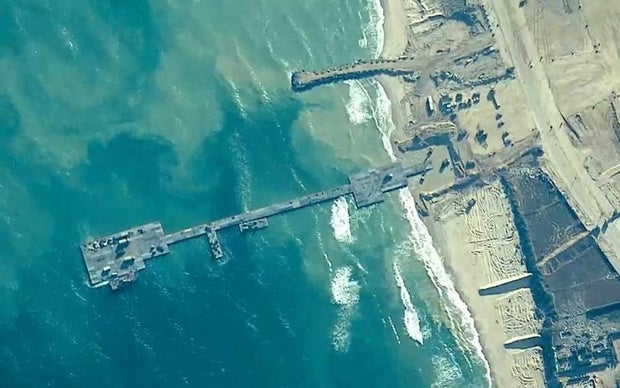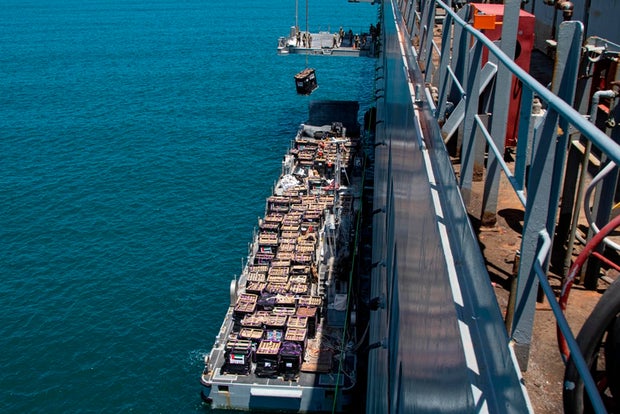Washington, the nation’s capital, For the first time, aid vehicles transporting essential provisions for the Gaza Strip traversed a recently constructed temporary U.S. floating pier into the besieged enclave on Friday. The region was unable to receive food and other essential provisions as a result of the intense fighting and Israeli restrictions on border crossings.
The cargo represents the initial phase of an operation that American military officials anticipate has the potential to transport as many as 150 truckloads per day into the Gaza Strip. This is in addition to the ongoing seven-month offensive against Hamas and the Israeli advance toward the southern city of Rafah.
However, the United States and aid organizations advise that the pier initiative should not be considered a substitute for land deliveries. Prior to the conflict, Gaza received an average of more than 500 truckloads of goods each day.
Israeli and American military personnel constructed Trident Pier, a temporary pier, in the midst of the ongoing conflict between Hamas and Israel to facilitate the delivery of humanitarian assistance to the Gaza coast. The wharf was depicted at this location on May 16, 2024.
The operation’s viability is threatened by the Israeli blockade of the Gaza Strip, which has persisted since Hamas’ attack on Israel on October 7, which resulted in 1,200 fatalities and 250 hostages. This blockade has caused logistical difficulties, the potential for militant assault, and an increasing shortage of gasoline for the trucks. Since that time, Israel’s offensive has resulted in the deaths of more than 35,000 Palestinians in the Gaza Strip and hundreds more in the West Bank, as reported by representatives of the Hamas-controlled Health Ministry.
The aid movement was confirmed by the Central Command of the United States military on Friday. The statement stated that the initial aid entered Gaza at 9:00 a.m. No American personnel were reported to have landed during the operation.
The command has stated that this is a continuous, multinational endeavor to provide additional aid to Palestinian civilians in Gaza through a maritime corridor that is exclusively humanitarian in character. The effort will involve the donation of aid commodities by a variety of countries and humanitarian organizations.
Aid was hoisted onto a vessel in Ashdod, a nearby Israeli port, as evidenced by photographs released by CENTCOM on Thursday. Gaza, where the humanitarian crisis has been further exacerbated by the ongoing conflict, is the recipient of the assistance.
Humanitarian aid was retrieved from a Navy causeway at the Port of Ashdod, Israel, on May 14, 2024, by members of the 7th Transportation Brigade (Expeditionary). This was accomplished using a crane. The military is assisting in the development of the Joint Logistics Over-the-Shore system off the coast of Gaza.
The dessert that floats The installation of the floating pier was completed by the forces on Thursday. The United Nations is accountable for the coordination of the distribution process. The Pentagon issued a statement hours later, verifying the imminent commencement of humanitarian assistance and preventing any potential disruptions.
Fuel is a critical issue.
The United Nations has reported that fuel shipments via land routes have virtually ceased. This will render the delivery of assistance to the Gazan populace exceedingly challenging.
Farhan Haq, the deputy spokesperson for the United Nations, declared, “We are in urgent need of gasoline.” “The delivery of aid to the population is contingent upon the availability of petroleum, regardless of whether it is transported by sea or land.”
According to SBrina Singh, a Pentagon spokesperson, hydrocarbon deliveries are a subject of discussion in every conversation between the United States and Israel. She also disclosed that the strategy is to progressively introduce the sea route and increase vehicle deliveries as the system resolves its issues.
The U.S. Agency for International Development and the World Food Program have reported that famine has established itself in the northern region of Gaza, while assistance organizations have reported that food and fuel are in short supply in southern Gaza.
Israel maintains that humanitarian assistance is not subject to any restrictions and attributes the United Nations’ backlog of products entering Gaza. The United Nations has reported that delivery has been impeded by fighting, Israeli fire, and disorderly security conditions. Israel is also apprehensive that Hamas may utilize the propellant in its resistance against Israeli forces.
Persistent challenges to delivery assistance
In response to U.S. pressure, Israel has recently opened two border passages to transport aid to the besieged northern Gaza. The country asserts that the movement of products has been impeded by a series of Hamas attacks on the primary crossing, Kerem Shalom. Additionally, Israelis have participated in violent demonstrations that have resulted in the cessation of relief deliveries.
Israel’s recent seizure of the strategic Rafah border crossing in the vicinity of the Egyptian city has resulted in the primary aid route into the Gaza Strip being cut off, raising concerns about the safety of civilians. This action is part of Israel’s offensive against Hamas.
The pier project is expected to cost $320 million, according to President Biden. The aid will be delivered by the aid organizations after they have deposited the boatloads of supplies at a port facility they have constructed to the southwest of Gaza City.
The initial aid shipment may have weighed as much as 500 tons, according to U.S. officials. The United States and Israel have maintained a close partnership in developing strategies to protect the personnel and vessels stationed on the shore.
Nevertheless, Sonali Korde, assistant to the administrator of the Bureau for Humanitarian Assistance of USAID, which is providing logistical support, has expressed apprehensions about the safety of assistance organizations that are facilitating food distribution in Gaza.
Korde stated that the operating environment is exceedingly precarious and that humanitarian organizations are still encountering challenges in obtaining authorization for their intended movements in Gaza.
The concern is a result of the recent deaths of seven World Central Kitchen relief workers, whose voyage was arranged in conjunction with Israeli authorities, and the loss of other aid personnel throughout the conflict at the hands of Israel.
It has been explicitly stated by Pentagon officials that security conditions will be closely monitored and that the maritime route may halt temporarily. Navy Vice Adm. Brad Cooper, the deputy commander of the U.S. military’s Central Command, stated to reporters on Thursday that “we are confident in the ability of this security arrangement to safeguard those involved.”
Hamas has already fired mortars at the construction site, threatening to target any foreign forces that “occupy” the Gaza Strip.
The vehicles will be transported onto the shore by third-country contractors, as Mr. Biden has explicitly stated that no U.S. forces will be stationed on the ground in Gaza. Cooper stated that “the United Nations will receive the aid and oversee its distribution to Gaza.”
According to United Nations officials, the assistance will be overseen by the World Food Program.
Despite the fact that Israeli forces are responsible for shoreside security, two U.S. Navy warships are in close proximity and can offer protection to American soldiers and others.
Prior to being transferred onto vessels and transported approximately 200 miles to the expansive floating pier constructed by the United States, the maritime assistance is collected and inspected in Cyprus. The vehicles subsequently transfer the containers to the Army vessels, where they are loaded. The vehicles immediately return to the boats after conveying the aid to the shore. The pallets are carried onto ships after being returned to the vast floating pier.


